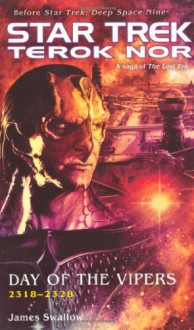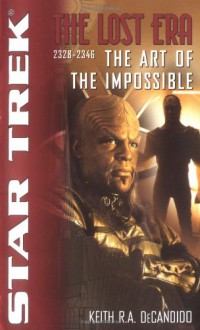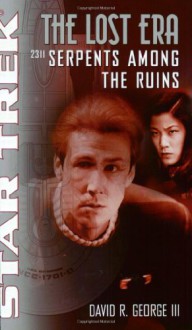
This book covers the years 2318 to 2328 - or rather, the day of official first contact between peace loving, religious Bajor and expansionist, war-torn Cardassia, up till the official start of the occupation.
It all starts when a Cardassian ship returns a lost Bajoran trading ship to Bajor. What is first seen as a friendly gesture by a race that some district ministers have contact with, leads to settlements of a persecuted religious minority (which bears similarities to Bajoran faith) and the presence of Cardassian military forces in Bajoran space. But Dukat and the Obsidian Order won't rest until Bajor is firmly under Cardassian jurisdiction.
This is a gripping account of the beginnings of Bajor's occupation, of how Cardassia slowly gains influence using puppets, sycophants, infiltrators and agitors and the actual occupation is practically a fait accompli even years before. It's a fascinating tapestry Swallow weaves about a forbidden religious minority that finds sanctuary on Bajor (but is used as a stepping stone in every way imaginable), about Dukat who abhors Bajor's richness in food (especially considering that his family is practically starving and immersed in civil unrest), its complacency, its strong religious foundation, about a kai who was shown in a vision an emissary would come, about the Obsidian Order's modus operandi and about the friendship of 3 Bajorans who are directly and indirectly affected by Cardassian presence on Bajor.
There are a few questions that remain, such as why Cardassia doesn't just invade, because Bajor has practically no defense ressources and invasion (or turning Bajor into part of their Union) was the goal from the start. At first Cardassia's still tied up with other military operations, so I'll grant them the first 5 years. But then? Perhaps it's the fact that although Bajor's in fact a conquered territory, that the Order managed to use their assets in a way that in the end it looked like the Bajoran government sanctioned, even asked for Cardassian troops to keep the peace. At least that's the reason (among others) why the Federation doesn't interfere. Bajor, after all, is an independent planet who decides its own fate - only that it doesn't really here.
But it's an intriguing tale about what it takes to make overt military action practically unnecessary, to destabilize a planet's government so that it practically asks for invasion. Compelling, and a bit frightening (especially given the recent talk about outside influence on elections) to think that one only has to manipulate a few spokes in order to get the whole wagon to tumble down. Definitely recommended - even if there are few better known characters in it, such as Dukat or Kotan Pa'Dar whose enmity with Dukat is explored a bit here. It just takes a while to really get going, but once it does it's difficult to put this book down.

 Log in with Facebook
Log in with Facebook 









